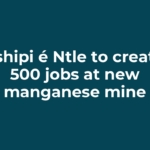Sod turning ceremony marks new era in manganese mining
South African manganese mining entered a new era today with the ceremonial sod turning of a majority black-owned managnese mine. The Tshipi Borwa mine near Mamatwan in the Northern Cape is one of the first mines to bring to fruition the government’s policy of distributing mining rights to a broader ownership for the benefit all South Africans.
“It is a milestone in the history of South Africa,” said Saki Macozoma, chairman of Tshipi é Ntle Manganese Mining and Ntsimbintle Mining.
Ntsimbintle is a broad-based black empowerment company that made Tshipi Borwa possible by putting together strategic shareholding and partnership deals. These gave the Tshipi Borwa mine access to the entire manganese value chain, from mine to market.
“Only a few years ago it would have been impossible for a black group like ours to have created a R1.7-billion mine. It has taken a sustained effort by a unique group of people to turn the dream of Tshipi Borwa into reality,” said Macozoma.
“Tshipi é Ntle Manganese Mining has brought together the skills, knowledge and passions of people with a common vision: to create a leading global manganese company that brings real benefits to South Africa and her people.
“It is a remarkable company that includes black entrepeneurs who have laboured for eight years to create this opportunity; skilled miners who are making certain that Tshipi Borwa is a modern and efficient manganese mine; and local community groups who are responsible for ensuring that the mine’s benefits go where they are most needed.
“The Tshipi Borwa mine will ensure that people who live in some of the most remote and poverty stricken areas of South Africa truly reap the benefits of the mineral resources beneath their feet,” said Macozoma.
Macozoma swopped his business suit for a hard hat when he ceremonially launched the construction phase of the Tshipi Borwa mine. With a jaunty thumbs up, he activated a bulldozer that scraped its massive bucket into the manganese rich Kalahari.
Also participating in the sod turning ceremony was a virtual “who’s who” of the global manganese industry. Among them was Brian Gilbertson, chairman of Jupiter Mines who leads the Pallinghurst Co-Investors, owners of 49.9 per cent of Tshipi é Ntle (through Australia’s Jupiter Mines). Mr Gilbertson noted that the exceptional resources on the Tshipi Borwa property would ensure that the mine produced top quality manganese for many years to come.
Picking up a spoon from the lunch table he said: “It is my hope that when my grandchildren pick up a spoon like this, the manganese in it will have come from Tshipi.”
Gilbertson said the idea of the mine came from Saki Macozoma. “When we started, we had two things, Saki Macozoma and a piece of veld. Today our partnership has created the Tshipi Borwa mine. It is worth pointing out that it is not enough to get the managanese from the ground; there is an entire distribution chain that has to be followed before the manganese gets to the consumer. Our partnership has also ensured that Tshipi has a mine-to-market strategy that will ensure economic viability.
“Experience has shown that resource rich countries like South Africa gain the greatest benefit by partnering with international investors and I think that the Thsipi Borwa mine is a fine example of this.”
Another strategic partner in Tshipi é Ntle is OM Holdings (OMH), an independent ASX-listed manganese producer that has a manganese mine in Australia, a sinter and alloy processing facility in China, and a marketing arm in Singapore. OMH will play a leading role in marketing the manganese ore that is mined at Tshipi Borwa, through a company called OMT.
OMT has been established in Singapore to market Ntsimbintle’s portion of Tshipi Borwa’s production. OMT The company is 70 per cent owned by OMH and 30 per cent by South Africa’s Ntsimbintle Mining.
Peter Toth, OMH’s chief executive, said that OMH is committed to mentor and train historically disadvantaged South African talent in its Singapore offices, focusing on the marketing and trading skills needed to sell commodities into Asia, notably China.
“The development of the Tshipi Borwa mine marks a major milestone in the future development of South Africa’s manganese industry and illustrates the structural changes taking place in the global manganese ore supply picture,” said Mr. Toth, who flew in from Australia to be present at the sod turning.
“Increasing demand from global and more specifically Chinese, steel producers will continue to underpin a very robust long-term demand for high-grade manganese ores. This, together with the gradual reduction in the supply of high cost and low grade manganese ores because of technical, commercial and environmental pressures, will ensure that Tshipi Borwa quickly becomes a prominent player in the industry through the long-term, reliable supply of high- grade seaborne ore products to the global steel industry.”
Among the other noteworthy milestones achievements of Tshipi Borwa is that the mine’s general manager, Mokgosi Nkoana, at age 34, is perhaps the youngest general manager of a major mine in South Africa today.
“I have been with the project since its inception,” said Nkoana. “Today I know how a new mother must feel, it’s been a long, hard labour but the result is a beautiful baby. Tshipi Borwa will grow into a mine that will serve South Africa when my grandchildren have grandchildren.”
Tshipi Borwa is an open pit operation set to commence production in 2012. The mine is designed to produce 2.4-million tonnes of top quality manganese ore every year for the next 60 years. It will employ 500 people.
Cynthia Mogodi, chairperson of the John Taolo Gaetsewe Developmental Trust, which is a shareholder in Tshipi é Ntle (through Ntsimbintle Mining), was also present at the sod turning ceremony.
“It should be made widely known and celebrated in South Africa that this is a majority black-owned mine that will help provide a better future for the people of the Northern Cape and generate tax revenues that will benefit all South Africans,” said Mogodi.
Mining at Tshipi Borwa will be a relatively simple “truck and shovel” open cast operation. Top soil will be removed and stockpiled for use in the rehabilitation phase and then the layers of the Kalahari formation will be removed to expose the manganese ore. This will be drilled, blasted and crushed to produce two products, namely “fines” and “lumpy product”. Manganese products will be loaded onto railway trains or road trucks from a state-of-the art rapid load-out station, currently under construction.
Tshipi é Ntle expects to utilise the ports of Port Elizabeth and Durban to export its manganese products. The company is confident that the planned expansion of Transnet’s rail and port facilities will enable the export of its products and support the growth of Tshipi é Ntle, a uniquely South African player in the global market for manganese.

